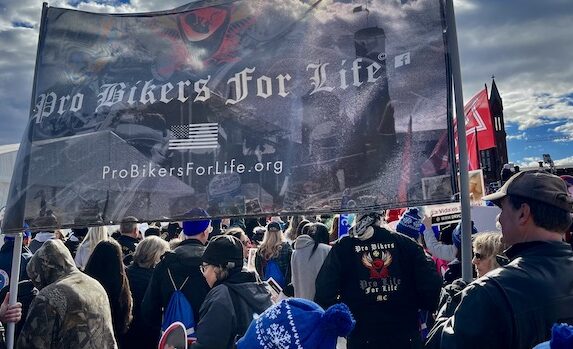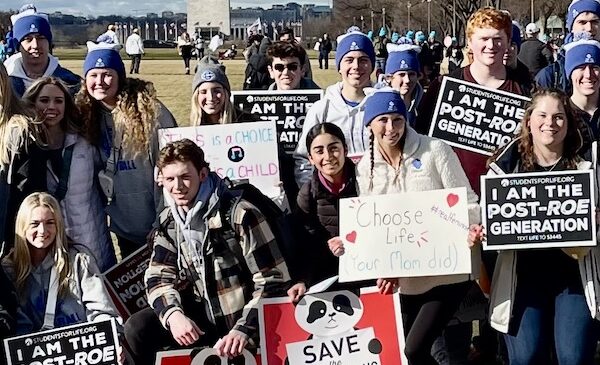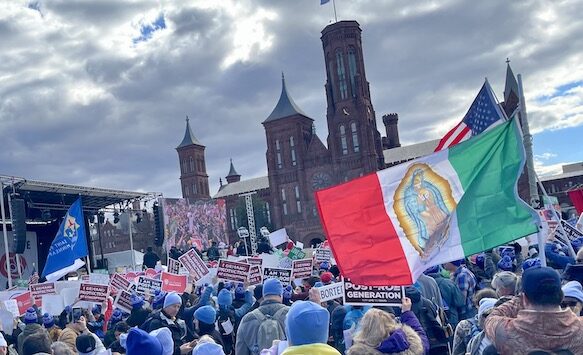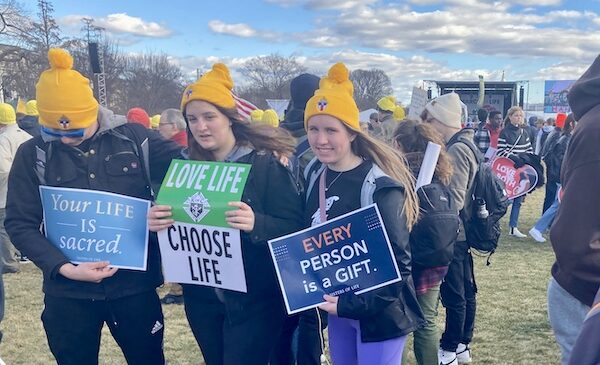WASHINGTON — The annual March for Life — protesting the Supreme Court’s decision legalizing abortion — did not skip a beat this year even though the court’s 1973 decision was overturned seven months ago.
Tens of thousands gathered Jan. 20 on a mostly sunny but blustery day in the nation’s capital, as they have for nearly 50 years, to send a message to lawmakers and the nation. And although participants celebrated the court’s recent decision in Dobbs v. Jackson Women’s Health Organization — that overturned Roe v. Wade — they were not about to stop there, stressing the need to keep up the fight until anti-abortion legislation is enacted at the state and federal levels.
At the start of the rally, held on the National Mall, Jeanne Mancini, president of the March for Life Education and Defense Fund, twice asked the crowd of primarily young people: “Should we still march?” and they responded with cheers.
She noted that the annual march, which started in 1974, “began as a response to Roe,” but stressed that it doesn’t “end as a response to Roe being overturned. Why? Because we’re not yet done!”
“This year marks our most significant victory,” she said, but added that the “human rights abuse from abortion is far from over.”
She also noted that activists will “continue to march” until abortion is a thing of the past and becomes unthinkable.
Some in the crowd who spoke with The Tablet echoed this same view, stressing that although they were pleased with the Dobbs decision, they also recognize the work ahead on the state level.
“It’s worse now,” said Cheryl Lambert, a chemistry teacher who accompanied a group of 68 students in two buses to the march from Catholic Central High School in Grand Rapids, Michigan. She said the “fight is where it should be, close to home,” but a long way from finished.
Similarly, a group of students from St. Agnes High School in St. Paul, Minnesota, said they felt the need this year to even be more involved in taking a stand by attending the annual march.
“Now the real fight begins,” said Elizabeth Grant, a senior.
David Guitter, a junior at Ave Maria University in Florida, said he initially “breathed a sigh of relief” after the Dobbs decision, followed by a realization of what this would mean locally in his state of Florida.
He was joined by other students at the march, including Bridget Bogan, a sophomore, who said about fellow marchers: “We are here to stay…we haven’t fallen off the map.”
That feeling was the day’s focus with the theme: “Next Steps: Marching in a Post-Roe America.”
Mississippi Attorney General Lynn Fitch reminded the crowd that her state’s case brought about the Dobbs decision, and she encouraged them to keep pushing for other triumphs in the pro-life arena. “This year’s different,” she told the marchers, but added: “This is not the end of our journey.”
She urged participants to channel the same spirit that has kept marchers going for nearly 50 years as they continue to work for changes in abortion laws in the country.
During the rally, nine representatives from Congress took the stage, and two addressed the crowd: Rep. Steve Scalise, R-Louisiana, House Majority Leader, and Chris Smith, R- New Jersey, co-chairman of the Congressional Pro-Life Caucus. Scalise thanked the young people in the crowd for their activism and urged them to continue the “next phase of the battle.”
He said in any battle, it’s important to celebrate victories, “and boy, did we get a huge victory just a few months ago when Roe was overturned.”
Scalise and Smith mentioned recent anti-abortion bills passed by House Republicans, and Scalise said young people need to vote and speak to their representatives and do more to continue these efforts.
“Clearly, a new national debate on abortion has begun,” especially at the state level, Smith said.
Celebrities who appeared on stage and likewise encouraged the group to keep their activism going included Jonathan Roumie, best known for portraying Jesus in the television series, “The Chosen,” and Tony Dungy, a former NFL head coach with the Tampa Bay Buccaneers and Indianapolis Colts.
This year, as in past marches, participants were bundled in winter gear to hear speeches and then filled the streets holding placards — saying “Choose Life,” “I am the Post-Roe Generation,” and “Let Life Happen” — but they walked a slightly different route to march past the Capitol’s West Front and finish between the Capitol and the Supreme Court.
The change was described by March for Life organizers as an effort to “give witness to the inherent dignity of the human person to pro-life and pro-abortion legislators alike, helping them understand that we will not cease advocating for women and children until every life is protected,” emphasizing that the need to “mark not only our victory in Dobbs but also our need to maintain a presence in Washington.”
Before the crowd took to the street, Mancini reminded them of the route change and encouraged them to stop and visit members of Congress and urge them “to support life-affirming policies.”
Bishop Michael F. Burbidge of Arlington, Virginia, who is chairman of the U.S. Conference of Catholic Bishops’ Committee on Pro-Life Activities, said a prayer at the start of the rally asking for God’s blessing on the crowd.
“Unite us as we march forward into a post-Roe America,” he prayed, echoing his message the previous night at the National Prayer Vigil for Life at the Basilica of the National Shrine of the Immaculate Conception.
In his homily at the vigil, Bishop Burbidge noted that although there was cause for celebration at this year’s march, participants should see this time as the start of a “new important phase of work in the pro-life movement” that requires those involved to be as “as tireless as ever.”




